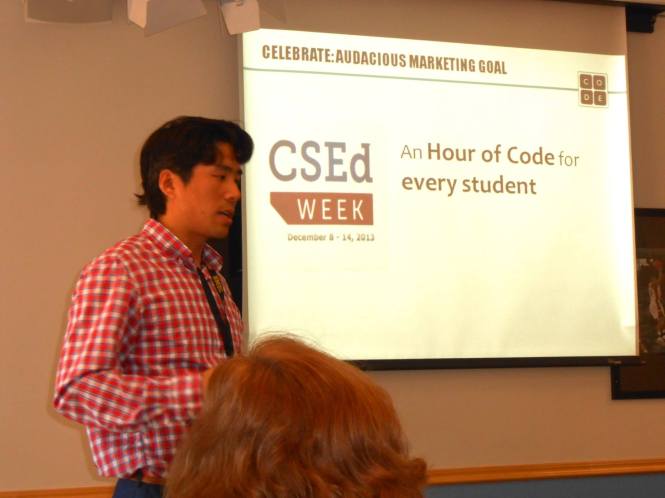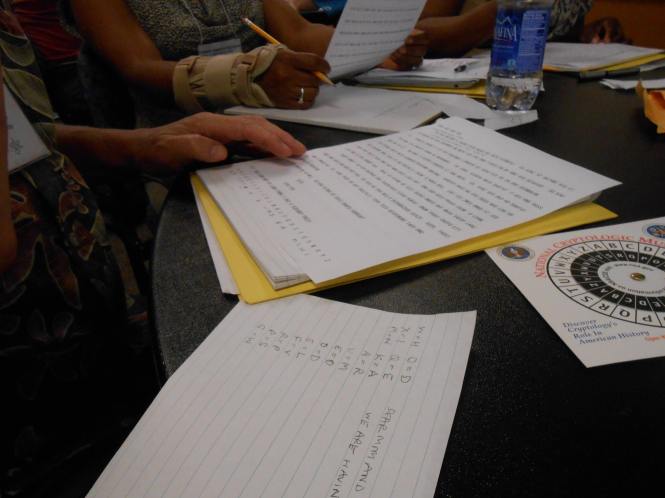
This article made me think of all of the people in education who have muted voices or no voices at all. It is probably because they don’t have technology, training, money, or time to make the difference that students need. They also can’t answer the experts , or share their sorrows in education. I think of them often. When I propose a workshop or a symposium, people start to tell me about the latest , hottest trend in education. Invisible students and teachers have no power. Even visible bad assed teachers can be shut out of the conversation and shut up.
Why are teachers cloaked in invisibility? Perhaps because we only ask the professors about research and not the working teachers. There are teachers and students in the world, in the US who are still not connected, and the way to get connected in their communities is difficult to find. We talk about the Internet of Things, and they have hardly the understanding of the uses of technology that are beneficial to them. I was told that sponsors don’t really care about digital equity, I don’t believe that.
I think it is difficult to walk in the shoes of those who work in rural, distant, urban, multilingual , and minority areas, but the work is necessary to lift all boats.
Teachers?
The public perception of the job is one thing. Being a good teacher is hard work.
The recent onslaught of attacks on teachers makes some of us like turtles. We withdraw and do our magic in the classroom as we can with what we have. The attacks make us insecure, and gives us feelings of unworthiness, sadness. Joy in the eyes of a child helps to take away the pain, or the discovery that some foundation, some credible agency understands how you feel makes for a quiet smile.
I like it that Richard Cullatta resigned and was not shy in his parting shots. The article is one that most people will never see or understand. But we in tribal. rural, distant, urban, and poor, the communities of those without the access, resources, savvy grant writers, technology trained teachers, and community support know exactly what he is talking about.
In his final public remarks as director of the Office of Educational Technology for the U.S. Department of Education, Richard Cullatta had a few requests.
Please don’t scan in the same old worksheets.
Please don’t record boring lectures and put them online.
Please don’t forget the needs of low-income and minority students, many of whom don’t have easy access to digital devices, speedy Internet service and advanced classes in computer science.
*I would add please don’t forget that there are many students with reading difficulty who think problem solving is a pain.
Culatta delivered his plea last week at National Education Week, an annual conference that was held this year at New York University’s Steinhardt School of Culture, Education, and Human Development. The outgoing federal leader spoke on a panel about teaching coding in schools, and he used most of his time in the spotlight to talk about equality. We must ensure that the rapid march of innovation does not leave certain groups of people behind, Culatta said.
He said ‘Women and minorities are underrepresented in computer science courses in high school and college. For instance, girls make up 56 percent of all test-takers in Advanced Placement courses, but just 18 percent of students taking computer science tests, Culatta said. It doesn’t get much better in college, where women make up about 57 percent of all undergraduates, but just 14 percent of them major in computer science. ‘
“And the inequality is even more stunning for people of color. In 12 states, zero students of color took the computer science Advanced Placement exam, Culatta said. And a mere 10 percent of people majoring in computer science are black.
“That’s an incredible problem that we need to solve,” Culatta said.
There are a lot of us who are not computer science teachers. But we have had support from the Supercomputing Conference which had an education section and we learned what we could in that precious space. For a while we also learned in the conference and at Shodor.org. Then I had a remarkable experience in the Atlas Institute , learning with Dr. Alex Repenning. We were learning scalable game design. He knows how to teach teachers who are NOT computer science teachers. ”
Sadly in the infrastructure of boards, and meetings , and groups who decide what goes on in education and who present in education we are an invisible force if present at all in the education groups.
ADVOCACY
 I learned as many others did at NASA, with the National Geographic Education Institute and alliances, with Earthwatch and the Jason Project. We teachers got to meet Bob Ballard, Bill Nye, and a number of astronauts and scientists .
I learned as many others did at NASA, with the National Geographic Education Institute and alliances, with Earthwatch and the Jason Project. We teachers got to meet Bob Ballard, Bill Nye, and a number of astronauts and scientists .
I had the power of the George Lucas Educational Foundation. When people were talking about Star Wars , they did not know that Edutopia is and has been a force in education for all.
We teachers also had the power of the NEA and its advocacies for diversity. McAuliffe, selected from more than 11,000 applicants to participate in NASA’s The Teacher in Space Project, had made plans to provide lessons from the shuttle on the benefits of space travel. Christa McAuliffe was a gifted social science teacher who was dedicated to her students and to the teaching profession.

Many of the projects in coding are absolutely wonderful. I loved weaving the Star Wars coding with reading of the books, and sharing science fiction, and NASA photographs and art and the movies in a mashup that few children could not be attracted to.
I am pretty savvy, so I did not even break a sweat. I walked into a lab and sat down with children I had never seen. We had a great time coding. We did not limit our time to an hour. We did various things in about 4 hours, and the kids wanted to stay longer.
*I am not in a classroom because I am a very experienced in technology and was asked to leave or give up technology during NCLB. So I left and became a consultant.
And then there is Cyberlearning. But, but.. without regular access how do we develop the skills, and deep learning. How sad it must be to understand the Internet of Things and to not have a learning landscape that is even good access.

Some of the teachers need their job so badly that they just go with the flow no matter how terrible it is. It is taken for granted that the experts in the silos of higher ed know the answers. Well, some of those experts are very isolated from the people who really teach.










 A mentor works with students in the Shodor Scholars Program
A mentor works with students in the Shodor Scholars Program
